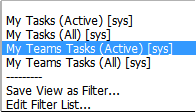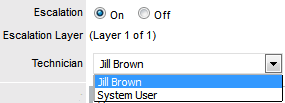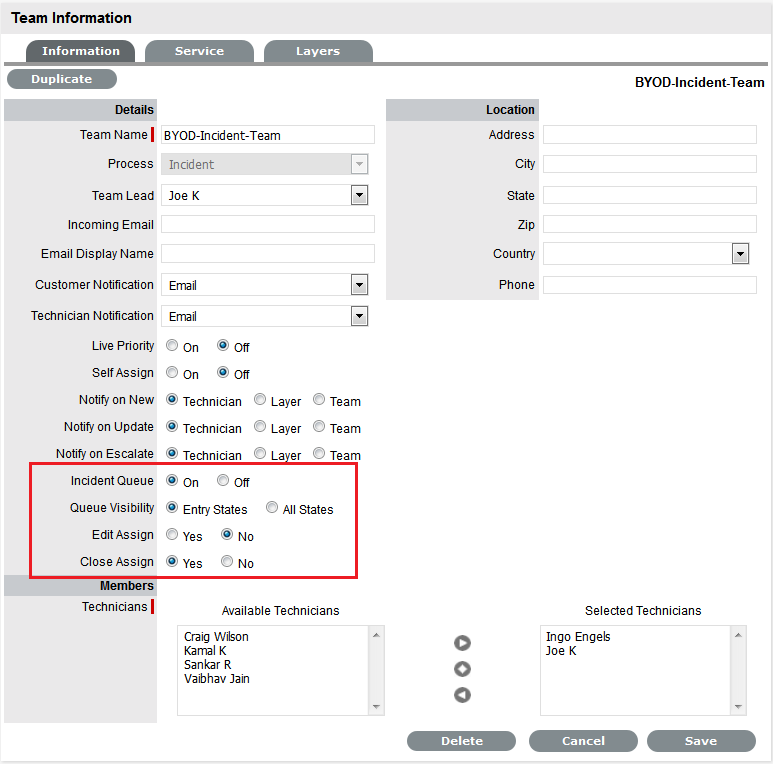1.25 Queues for requests
The Queues functionality allows for requests, Incidents, Service Requests or Problems, to be assigned to the System User as part of a Team holding bay. Users within the Team with the Queue option enabled can select relevant requests they decide to work on, or manually assign the System User assigned requests to an appropriate User.
Requests that are assigned to the Queue are allocated to the System User, until they are manually reassigned to a specific User. The unassigned requests are located within the Home tab My Teams Queued Tasks, or the Operations>Incidents tab Filter option called Incident Queue for new Incidents, the Service Requests within the Service Request Queue in the Operations>Service Requests tab and the Operations>Problems tab Filter option called Problem Queue for new Problems .

When the Queue feature is enabled for the application, it can be applied on a Team by Team basis. This means some Teams can be configured to use the business logic of the application for assigning requests to specific Users. While other Teams can use the Queue to select the requests they want to work on, or allows other Users to manually assign the request to a relevant User.
When the Self Assign and Queue options are enabled for a Team and a request is created by a Technician User, the Self Assign option will override the Queue assignment and allocate the request to the User creating the request, if they are in the first layer of escalation. The User can assign the request to the Queue by selecting the System User in the Technician list.

1.25.1 Enabling the Queue
By default, the Queue functionality is disabled in the application Setup. To enable the Queue:
-
Log in as an Administrator
-
Select Setup>Privileges
-
Select the Request tab

-
Enable the Queues option
-
Click Save.
To enable the Queue for a Team:
-
Log in as a Supervisor
-
Select the User>Teams option
-
Select the relevant Team link

-
Click Edit
-
Enable the Queue option
The following options can then be applied to the Queue:
-
Options
Description
Service Request /Incident/Problem Queue
Allows the Team to use a holding bay for Incidents that are received via email or the Customer Portal. (This option is visible if it has been enabled by the Administrator.)
If the Team has only one Technician assigned to Layer One of Escalation, new Incidents are automatically assigned to that Technician and that Technician is notified of the new Incident assignment.
If the Team has multiple Technicians assigned to Layer One of Escalation, the new Incident is placed in the Queue (i.e., it is assigned to the System User) and all members of the Team are notified that a new Incident has been assigned to the Incident Queue. See: Queues.
Queue Visibility
When the Incident Queue is enabled, the option can be refined to allow the Queue to be available for assigned Workflow entry points, or all stages of the assigned Workflow. If All States is enabled, Users can move requests back to the Queue throughout the request lifecycle. See: Queues.
Edit Assign
When set to Yes and a request assigned to the System User (i.e., Queue) is opened in Edit Mode, the system will automatically assign the request to the User editing the request if they are in the Escalation Layer associated with the request.
Close Assign
When set to Yes and a request assigned to the System User (i.e., Queue) is moved to an Exit State of the Workflow, the system will automatically assign the request to the User who prompted the close action.
-
Set the Queue Visibility
Select All States if Team members are to be allowed to return a request to the Queue regardless of the assigned Workflow State.
-
Set the Edit Assign option
Select Yes, if a request that is assigned to the System User/Queue is to be automatically assigned to a User in the first layer of escalation who opens the request in Edit mode.
-
Set the Close Assign option
Select Yes, if a request that is assigned to the System User/Queue is to be automatically assigned to the User who initiates an action that results in the request being moved to an Exit State.
-
Select Save.
1.25.2 Assigning requests from a Queue
All requests displayed within a Queue list are assigned to the System User. To reassign the request to an appropriate User:
-
Select the Request # hyperlink
-
Click Edit
-
Select an appropriate User from the Technician list
The request will now be assigned to the new User and removed from the Queue.

-
Click Save.
1.25.3 Reassign a request to the Queue
When the All States option has been enabled for the Queue within the Team Information screen, the System User will be retained in the Technician drop-down list for the first layer of escalation after it has been assigned to a User. This allows the assigned User to re-assign the request back to the Queue.
To reassign the request to the Queue/System User:
-
Select the Request # hyperlink
The request should be at layer one of escalation within the assigned Team.
-
Click Edit
-
Select System User within the Technician drop-down list
The request will now be assigned to the System User and returned to the Queue.

-
Click Save
-
Click Done.
The system returns to the request list view.
1.25.4 Queue Filter
Teams that use the Queue method for request assignment can view and allocate requests using the My Teams Queued Tasks within the Home tab list filter, or within the Service Request, Incidents or Problems tab Queue list filter. They can also see Queued Tasks within the My Teams Tasks filters.
To view all types of requests assigned to the Queue within one list, use the My Teams Queued Tasks within the Home tab:
-
Select the Home tab
-
Go to the Filter List
-
Select the My Teams Queued Tasks option from the drop down list.
The screen will list all of the Service Requests, Incidents and Problems that are currently assigned to the System User.

To view the Queue within the Service Requests tab:
-
Select the Operations>Service Requests tab
-
Go to the Filter List
-
Select the Service Request Queue option from the drop down list.
The screen will list all of the Service Requests that are currently assigned to the System User.
To view the Queue within the Incidents tab:
-
Select the Operations>Incidents tab
-
Go to the Filter List
-
Select the Incident Queue option from the drop down list.
The screen will list all of the Incidents that are currently assigned to the System User.
To view the Queue within the Problems tab:
-
Select the Operations>Problems tab
-
Go to the Filter List
-
Select the Problem Queue option from the drop down list.
The screen will list all of the Problems that are currently assigned to the System User.